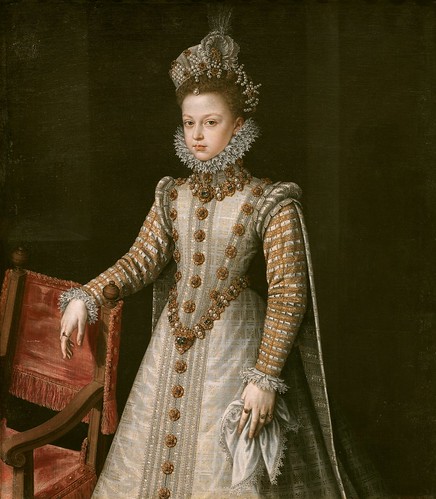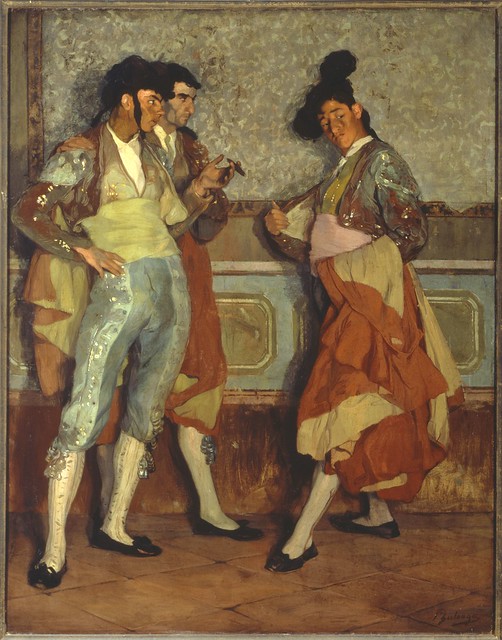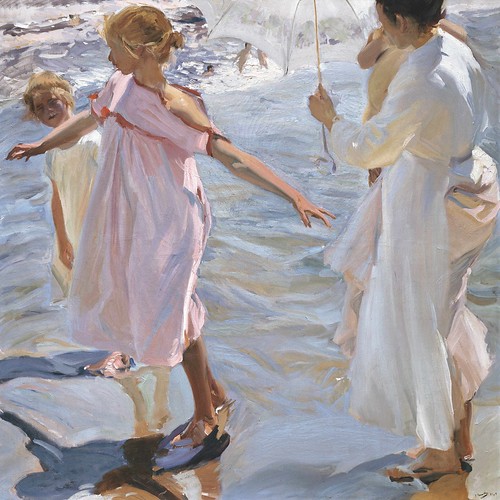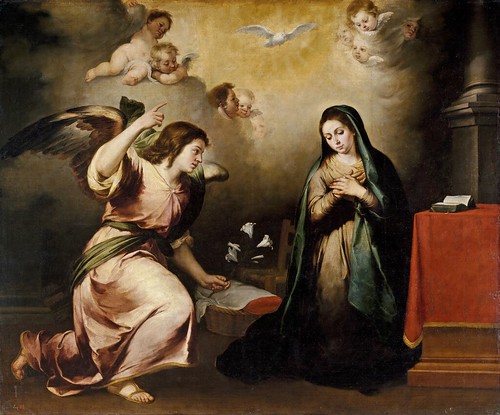The city of San Antonio is celebrating 300 years since its founding by Spanish friars and Spanish settlers with historic events all year. That’s why the “Summer in Spain” initiative focuses specifically on the city’s artistic Spanish heritage.
With that in mind, the San Antonio Museum of Art is hosting a blockbuster exhibit titled Spain: 500 Years of Spanish Painting from the Museums of Madrid. The exhibition is made up of more than 40 artworks, some of which have not been seen in San Antonio or in the U.S.
Adding a royal touch to the celebration is Spain’s King Felipe VI and Queen Letizia. When they arrive on June 16, their itinerary will include a private preview of the exhibit. Spain officially opens Friday, June 22, and remains open until September 16, 2018.

Alonso Sánchez Coello (Spanish, ca. 1531-1588), The Infanta Isabel Clara Eugenia, 1579. Oil on canvas, h. 45 11/16 in. (116 cm); w. 40 3/16 in. (102 cm). Museo Nacional del Prado, Madrid, P01137
© Museo Nacional del Prado, Madrid.
“Spanish artistic traditions are part of the formative influences upon the culture of San Antonio,” says Katherine Crawford Luber, Ph. D., SAMA director and one of the organizers. “Over and over again, motifs from Spanish art became part of the visual language of art made and used in New Spain.”
Masterpieces from Velazquez, Murillo, Goya, Picasso, El Greco, and other great Spanish artists represent a unique time in history, such as the marriage of Queen Isabella and King Ferdinand in the late 15th century.

El Greco (Greek, active Spain, 1541-1614), The Annunciation (La Anunciación), ca. 1596-1600. Oil on canvas, h. 44 7/8 in. (114 cm); w. 26 3/8 in. (67 cm). Museo Thyssen-Bornemisza, Madrid, 171 (1954.1)
The artworks also reflect decades of art history, from the Renaissance through the turn of the 20th century. Most of the artworks speak volumes about what was taking place socially, economically, and, of course, politically in Spain.
For example, Francisco de Goya y Lucientes, born in 1746, chronicled the French invasion of Spain by Napolean in select paintings. Two of note are: “El Dos de Mayo 1808” y “El Tres de Mayo.” Although not included in this exhibit, they are Goya’s way of commenting on the brutality of the war.
Diego Velazquez, born in Sevilla in 1599, was the most significant Spanish painter of the 17th century. His portraits of live models and still-life paintings are magnificent. His masterpiece, “Las Meninas,” or “The Ladies-in-Waiting,” is his most famous painting; it graces the walls of the Prado Museum in Madrid.
Eight Madrid museums, including Museo Nacional del Prado, Museo Nacional Centro de Arte Reina Sofia, Museo Thyssen-Bornemisza, Museo Fundación Sorolla, Museo de la Real Academia de Bellas Artes de San Fernando, Museo Cerralbo, Museo de Romanticismo, and Fundación Lázaro Galdiano have sent their exquisite artworks for the duration of this exhibition.

Ignacio Zuloaga (Spanish, 1870-1945). Young Village Bullfighters (Torerillos de pueblo), 1906. Oil on canvas, h. 77 9/16 in. (197 cm); w. 60 5/8 in. (154 cm). Colección Museo Nacional Centro de Arte Reina Sofía, Madrid, AS0819 © 2018 Estate of Ignacio Zuloaga, Artists Rights Society (ARS), New York. © Photographic Archives Museo Nacional
American contributions to the Spain exhibit include loans from Dallas’ Meadows Museum, Museum of Fine Arts, Houston, Museum of Fine Arts, Boston, Cleveland Museum of Art, and the Virginia Museum of Fine Arts. All the artworks combined serve to bolster this rare and outstanding exhibition.
Spanish painters were influenced by other European artists in Italy, France, and Flanders. Soon enough, however, they began to chronicle their own lives and times in the diverse, ever-expanding Iberian Peninsula.
Pictorial traditions, such as portraiture, religious paintings, still life, and landscapes-from the dawn of naturalism to impressionism and expressionist movements-are all represented through the country’s iconic artists.
The impact of Spanish artists and their paintings was so pervasive throughout the vast Spanish empire-stretching from the Mississippi and throughout much of the Southwest of the United States- that the visual language of art has continued into modern times.
Artistic influences with Spanish motifs can even be found in San Antonio’s five Spanish missions, declared “World Heritage Sites” by the United Nations Educational, Scientific, and Cultural Organization (UNESCO) in July 2015.
Now, for the price of admission to the museum, visitors can travel vicariously through Spain, under Muslim rule for nearly eight centuries. Then, it was finally restored to Christianity in 1492 by legendary Catholic monarchs, King Ferdinand and Queen Isabella.
When SAMA conceived the initiative it calls “Summer of Spain,” the goal was to offer its visitors an unforgettable experience by immersing them in all things Spanish. To that end, the museum will offer a series of educational lectures, film festival, poetry readings, and art-making.

Joaquín Sorolla y Bastida (Spanish, 1863-1923), Bath Time, Valencia (La hora del baño, Valencia), 1909. Oil on canvas, h. 59 in. (149.9 cm); w. 59 1/4 in. (150.5 cm). Fundación Museo Sorolla, Madrid, 00835
Additionally, through its Festival de Arte, patrons can take flamenco lessons or enjoy a social event featuring wine and tapas tastings. The project has inspired local organizations, including the Guadalupe Cultural Arts Center, Southwest School of Art, San Antonio’s La Casa España, and others to get involved.
“With this exhibition, our residents and visitors will have a chance to engage with extraordinary works of art as we celebrate our city’s 300-year history and look to its future,” said Dr. Luber, who was joined in organizing the exhibit by SAMA’s Chief Curator, Dr. William Keyse Rudolph, who is also the Marie and Hugh Halff American Art curator.
“We’re immensely grateful to our partners in Spain and the United States who understand the importance of this anniversary year to the city and were willing to share their treasured paintings for our community to enjoy,” she added.

Bartolomé Esteban Murillo (Spanish, 1618-1682), The Annunciation (La Anunciación), ca. 1650. Oil on canvas, h. 72 1/16 in. (183 cm); w. 88 9/16 in. (225 cm). Museo Nacional del Prado, Madrid, P00969 © Museo Nacional del Prado, Madrid.
Admission to the museum is $20 for adults, $17 for seniors and $12 for students. Children 12 and under are always admitted for free. But for this exhibition, there will be a $5 fee. General admission is free from 4 to 9 pm on Tuesdays and 10 am to noon on Sundays. But a $5 fee will be charged for the exhibit. The SAMA is closed on Mondays.
Although organized by SAMA, the exhibition is presented by Bank of America, and funded by Carlos and Malu Alvarez, American Airlines, the Brown Foundation and the Elizabeth Huth Coates Foundation of 1992.
Support for this outstanding exhibition also comes from the Spanish Embassy in Washington, D.C. and the Ministry of Education, Culture, and Sports in Madrid, Spain.
For more information on the San Antonio Museum of Art, 200 W. Jones Ave. For questions about the Spanish exhibit, visit https://www.samuseum.org, or call the main number: (210) 978-8100. You can also check the museum calendar of events at www.samuseum.org/calendar.
Rosie Carbo is the Lifestyles Editor for Wandering Educators, and is a former newspaper reporter whose work has appeared in newspapers and magazines nationwide. Some of those publications include People magazine, The Dallas Morning News, The Houston Chronicle, and San Antonio Express-News. Some of her features were redistributed by The Associated Press early in her career as an award-winning Texas journalist.
All photos used with permission.
